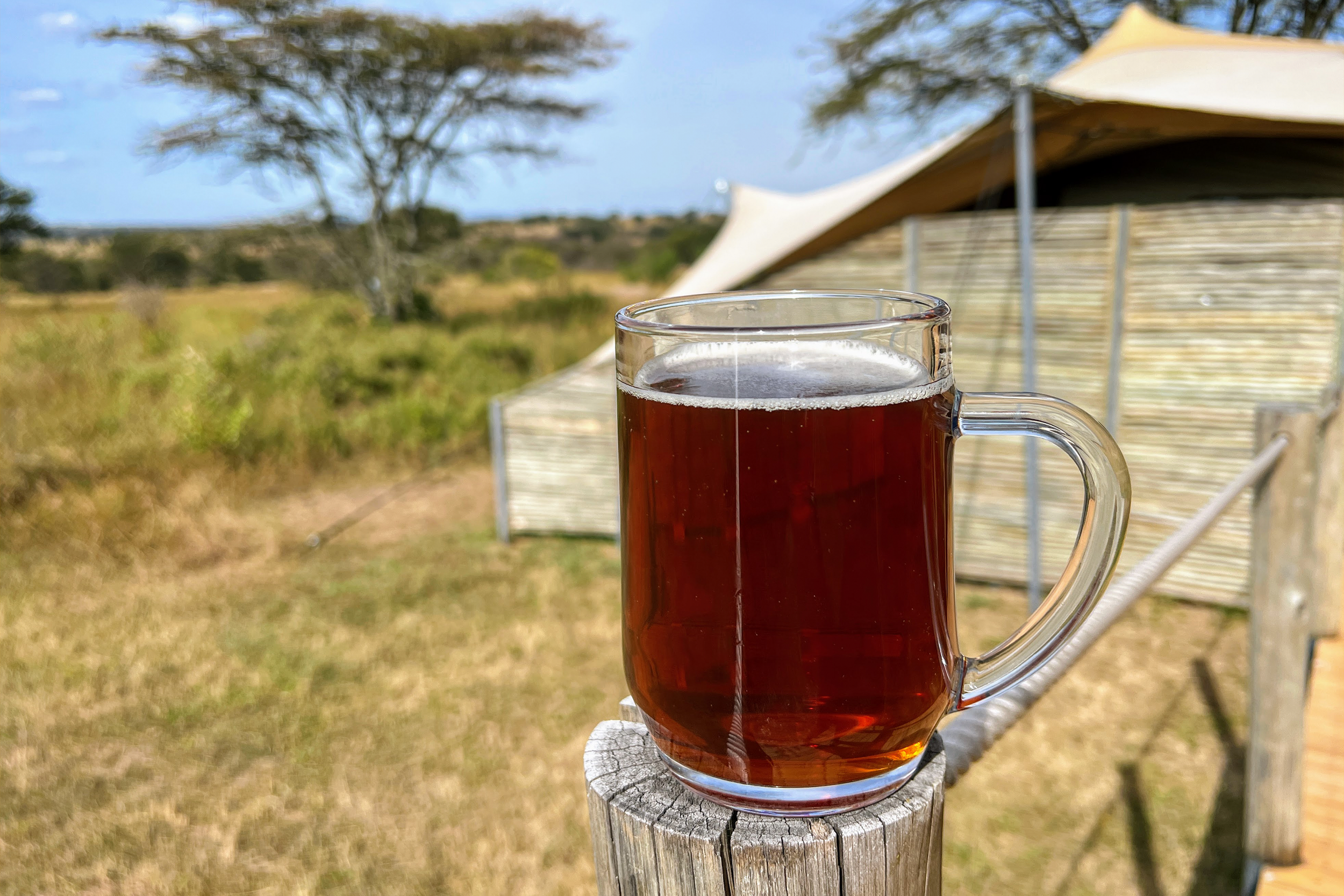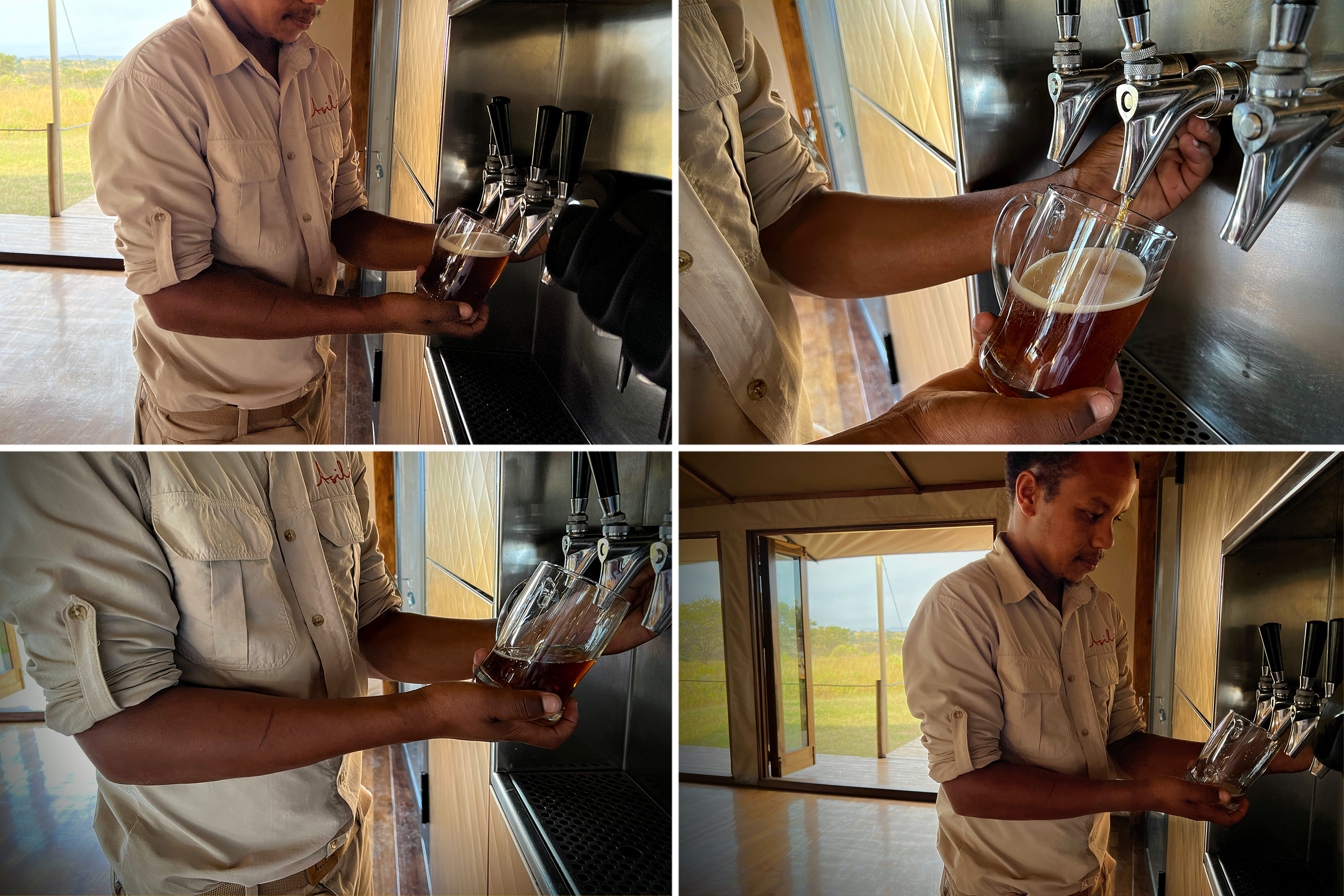“They are moving at Crossing Six! Hang on!” William shouts. He shunts the radio back into its receiver and revs the engine of our open-air safari 4x4.
Uh oh, I think, glancing down at the metal cup in my hands. I barely have time to belt in before William wheels the 4x4 around and blazes down a narrow track, the wilds of the African savannah visible through the vehicle’s open sides. I look back. Shay and Kylie, the honeymooning couple in the seat behind me, are hanging on for dear life.
To call this ride “bumpy” would be generous. I’m fairly sure the wheels catch air. But William is an experienced guide—he dodges flat-bottomed acacias and spiky whistling thorn trees, leaving a plume of thin dirt behind. Out of the bush to our right, other safari vehicles appear alongside us at equal speed in an exhilarating, dusty chase. And the Mara River is ever to our left, carving an understated, slate-blue ribbon through boulders so numerous they look like marbles scattered from a God-sized bag.
Finally, a herd appears in front of us: thousands upon thousands of wildebeests streaming like ants, jumping and splashing into the water, swimming and emerging slick and wet on the other side. Sometimes scrambling for their lives up the boulders. Sometimes confused and turning back toward where they came from. All of them lowing in a continuous, bone-rumbling hum.
The vehicle comes to a halt on a bluff overlooking the rocky riverbed.
“Wait, what did you do with your beer?” Shay asks.
“It’s here,” I grin. I hold up my cup with my palm over the top to show how I’d kept out the dust. He looks impressed and asks me to pour him a cup, too.
We sit back and watch the spectacle of the wildebeests crashing across the Mara in an endless flow. The herd extends for some 300 miles, starting their annual pilgrimage northwards from the Serengeti to the Maasai Mara in Kenya. They’re following rainfall to greener pastures, never more necessary than during this year’s punishing dry season.
An extended drought across the Serengeti and neighboring Maasai Mara, caused by global warming, has seen water levels drop in the Mara River, resulting in catastrophes for countless communities and changes to species behaviors. Scientists have warned that increasing desertification in the region could halt the wildebeest migrations altogether. For now, we take in the enormity of the event with awe.
I’d found the beer, an English-style IPA called Chungu, in a cooler between the seats of the 4x4, and had given myself a generous pour. Chungu, meaning “bitter” in Swahili, is brewed at Sayari Camp’s own microbrewery. In 2020, while the world fell into a pandemical stillness, Sayari forged ahead with its plans to open the first microbrewery in the Serengeti—a totally solar-powered operation, and the only brewery of its kind in the African bush.
It wasn’t a vanity project. The brewery was added when Asilia Africa—Sayari’s parent company—decided to install a water-treatment kit as part of its strategy to become completely carbon-neutral, and to eliminate plastic waste. The kit would also contribute to the surrounding area by providing clean, filtered drinking water to nearby communities, including villages, the ranger station, the airstrip, and other safari camps. In a way, the beer is a bonus.
The system is a remarkable piece of equipment created by Wayout, a Swedish start-up that makes what it calls the “micro-factory.” It is a shipping-container-sized system that not only purifies and desalinates water, but can brew beer and make sparkling water, sodas, and other drinks.
“In 2020, while the world fell into a pandemical stillness, Sayari forged ahead with its plans to open the first microbrewery in the Serengeti—a totally solar-powered operation, and the only brewery of its kind in the African bush.”
So far, Sayari has supplied approximately 31,965 gallons of water to the local community, the equivalent of 255,720 16oz, single-use water bottles. This has reduced plastic waste substantially by allowing the transportation of filtered water—sourced from a borehole at the camp—in tanks or smaller, reusable bottles.
The brewery further reduced the camp’s carbon footprint by removing the need to truck in kegs or bottled beer from one of Tanzania’s two main macro-breweries: Tanzania Breweries, which makes local brands like Castle Lager and Kilimanjaro Lager, and Serengeti Breweries. Instead, Sayari is now supplying fresh tank beer to its guests as well as kegs for sister camps nearby.
You can hear the wildebeests’ steady stream of long, resonant moos everywhere near the camp, which sits on a golden hillside above the Mara River, less than six miles from the Kenyan border. The river is just out of sight from the main lodge, which is a permanent structure made of mahogany and canvas on a stilt frame that prevents disruption to the soil.
On my first afternoon, I rinse off the 4x4 dust in an open-air shower in my tent suite, and head down to the main lodge for a refreshment. I’m greeted by Yahaya and Frank, Tanzanian twenty-somethings who run double-duty tending bar and serving tables in the lodge. Frank pours me a pint of the house Pilsner and I settle into a seat at an open-air bar overlooking the bush. Nearby, three rock hyrax—gopher-like mammals that are surprisingly closely related to the elephant—are sitting fur-bellied on boulders into which the camp’s swimming pool is built. They eye me suspiciously.
The Lager is unusual: nutty and malt-forward, with a bitter finish reminiscent of a Kölsch, but still fresh and quenching on an arid afternoon. Its straw color matches the hills of the bush, where in July, the dry season has rendered the grass a honey gold—beautiful and terrible in equal measure.
When I first arrived in Tanzania, Neema—a guide at the continent’s only women-run safari camp—scolded me to hydrate. “Drink,” she said, “because water is life.”
In the dry season, life struggles. As the plains wither, animals must travel to eat, sometimes crossing hundreds of miles. The wildebeest move en masse in search of fresh grass, heading northward to the lush Maasai Mara during the arid months between June and October, and then returning south to the Tanzanian plains with the rains in November.
Grazing animals can’t get nutrition from dead grass, so to encourage new growth, rangers in Tanzania’s national parks remove the dried-out top grass with fire, a process of controlled burning. For three weeks every July, the air is thick with smoke and the land turns black and sizzles under the red-hot Serengeti sun, which rises and sets in flaming oranges and magentas. Safari vehicles kick up charred clouds of ash and dirt in their wake. Sinister dust devils spin across the scorched bush like desert tornados.
“In the dry season, life struggles. As the plains wither, animals must travel to eat, sometimes crossing hundreds of miles.”
And life stays close to the river. Adult crocodiles only eat around 50 full meals a year, sometimes going several months or more without feeding. The wildebeest migration represents the most nutritionally important time of year for a croc, and they lie in wait to pick off the young or weak wildebeests as they make their treacherous crossing of the Mara River.
This only gives my sensitive soul a small amount of solace the first time we see a croc grab a beest and pull it under the water. The beest struggles and tries to stand; the croc keeps its jaws locked around a hind leg. A croc will keep hold of a wildebeest, tiring it out and eventually pulling it underwater to drown. This violent, evolutionary dance goes on for many minutes, keeping us mesmerized equally in horror and fascination.
Back at the camp, Frank tells me about his childhood in the bush while I sip Pilsner from a glass tankard.
“It was no big deal to walk four hours to school,” he says. “Sometimes you see a lion or an elephant. You just keep walking.”
He tells me he enjoys being a waiter but his real goal is to become a safari guide—a common sentiment among many of the staff members I speak to in Tanzania. He says there are opportunities to move up and learn, and he will try to join the company’s guide training program—a competitive, in-house school for safari guides.
In a country where almost 40% of the land is protected as national parks and reserves, jobs in safari tourism offer some of the most reliable, gainful employment. Tourism has statistically cut down poaching and provided means for conserving the country’s invaluable biodiversity, as well as its rural communities.
“This is my homeland,” Frank says. “It’s good for someone like me to be a guide because I have learned the land and the animals from the time I was young. I know this place in my soul.” He pauses and looks at the sky, which is turning a pastel shade of purple as dusk settles over us. “How’s the beer?”
Our conversation turns to the brewery, and Frank says he loves beer and tells me beer drinkers are his best guests because they are friendly and excited to find out about the microbrewery. “You can always talk with a beer drinker. They are easygoing,” he laughs.
The next day, I find Balthazary Tarimo—brewery technician—with his head lodged in a stack of small fermentation tanks, which occupy a corner of the bar area. He stands, brushes off his gray coveralls, and flashes a wide smile.
“Call me Bally,” he says, inviting me inside the tiny brewing kit. I duck under hoses and he shows me the four osmosis filters that purify borehole water and sift out sand on the left side, and a pair of four-barrel brew kettles which take up most of the rest of the shipping container. The brewery makes four beers—a Pilsner, a Blonde, an IPA, and a Brown Ale—and uses extracts and hop oils to avoid the need for excess equipment or mash waste.
“I duck under hoses and he shows me the four osmosis filters that purify borehole water and sift out sand on the left side, and a pair of four-barrel brew kettles which take up most of the rest of the shipping container. The brewery makes four beers—a Pilsner, a Blonde, an IPA, and a Brown Ale—and uses extracts and hop oils to avoid the need for excess equipment or mash waste.”
Bally was already working at Sayari when the plan for a brewery was announced. A beer lover, he immediately expressed interest and was offered the chance to step up as technician and brewer. Before working in the safari industry, he was an electrician in Arusha, the main city in northern Tanzania—a skill which he says comes in handy when managing the brew kit.
To ease the tremendously complex process of brewing in the bush, Wayout pre-programmed the kit with four recipes and sources all of the ingredients, sending supply runs of hop oil, both Bavarian and U.S., and malt extracts to the local airstrip on a regular basis. This doesn’t leave much room for Bally to play around with the recipes, but he says he’s keen to try if they are ever able to deviate from the ingredients list.
On my final evening, Frank pours me an IPA and I sit outside again, watching the savannah slowly darken, listening to the sounds of the wildebeest herds still flowing across the Mara. Kylie and Shay arrive and pull up chairs next to me and we remark on the magical way that four simple ingredients can produce such different flavors depending on where beer is made.
Shay says he doesn’t think the IPA tastes like an IPA. And he’s not wrong—this is no New England juice bomb. It is a rich, amber Ale the color of a gazelle with a strong, lemon finish. It is raw—earthy, grassy, and herbal. Like the wild, burnt aromas of the bush.
[Disclosure: This trip was made possible by Asilia Africa, and we’re grateful for their help in making our coverage of the African continent more comprehensive.]























